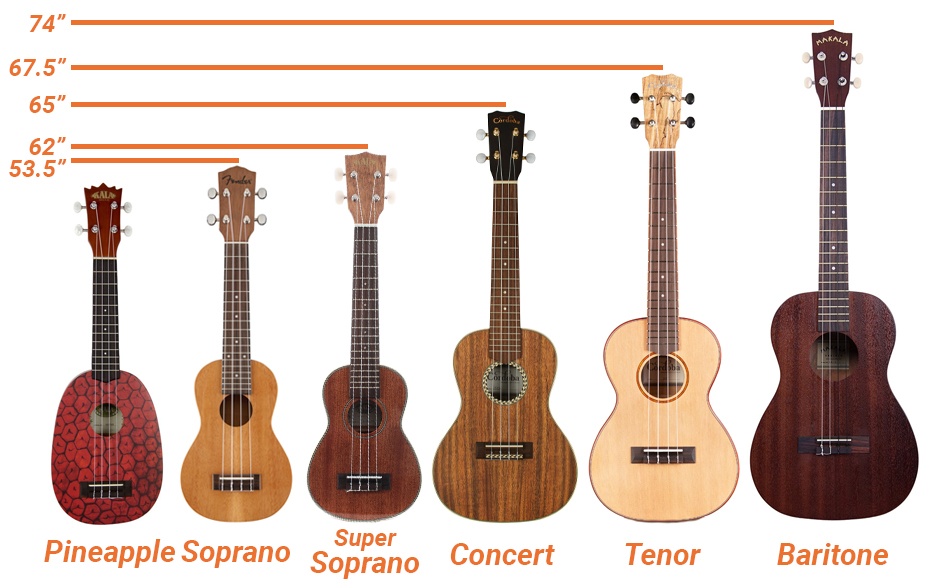Guide To Ukulele Sizes: 10 Types Of Ukuleles-Nepal

What Is A Ukulele?
A ukulele, also known as uke or ukelele, is a small stringed instrument that originated in Hawai‘i. Similar in shape to a guitar, a ukulele has four nylon strings that musicians play by strumming with their fingers or a pick. The name “ukulele” roughly translates to “jumping flea” in Hawaiian, which, according to one origin story, refers to the energetic look of players’ fingers while fingerpicking.
Ukuleles can be made from any number of woods, including laminate wood, solid cedar, rosewood, and tonewoods. Koa, a Hawaiian acacia wood, is among the most popular woods used to make ukuleles.
Ukuleles are Hawaiian stringed instruments that look like small acoustic guitars. There are multiple types of ukuleles with distinct sounds and qualities.
10 Different Ukulele Sizes
The four main types of ukuleles—soprano, concert, tenor, and baritone—are distinguished by their size. In addition to those four, there are six less common types of ukuleles in different shapes and sizes.
- Soprano ukulele: The soprano ukulele has a standard tuning of G-C-E-A. This ukulele is the smallest in size, with a standard length of 21 inches.
- Concert ukulele: The standard tuning of a concert ukulele is also G-C-E-A. This type of ukulele is slightly larger than the soprano size, at around 23 inches.
- Tenor ukulele: Like soprano and concert ukuleles, the tenor ukulele has a standard tuning of G-C-E-A. It has a larger body—around 30 inches in length.
- Baritone ukulele: The baritone ukulele is also 30 inches in length, but it is slightly broader than a tenor ukulele. It has a richer, deeper sound and is tuned to D-G-B-E
- Guitar ukulele: Also known as a “guitarlele,” this ukulele has six strings, like a guitar.
- Bass ukulele: A bass ukulele has the tuning of a bass guitar (E-A-D-G) and the body of a baritone ukulele.
- Banjo ukulele: Also known as a “banjolele,” the banjo ukulele has the body and sound of a banjo, but the size of a traditional ukulele.
- Electric ukulele: Like an electric guitar, an electric ukulele can be electronically amplified.
- Sopranino ukulele: A very small ukulele that is smaller than a soprano ukulele. The sopranino ukulele has ten frets and is 12 inches in length.
- Pineapple ukulele: The pineapple ukulele is shaped differently than a standard ukulele. Instead of the classical figure-eight shape that most ukuleles have, the pineapple ukulele has a rounder shape that resembles a pineapple. This shape gives the instrument a louder sound and sweeter tone.
3 Things To Consider When Choosing A Ukulele
If you’re a beginner, these tips will give you a broader understanding of how to choose your first ukulele.
- Wood vs. laminate: Like all instruments, the ukulele’s material determines its sound. Play around with ukuleles of different tonewoods (like koa, cedar, and redwood) or laminates to determine the right sound for you. Generally, avoid plastic ukuleles.
- Large vs. small: Different sizes of ukuleles don’t just sound different; they’re also played slightly differently. Beginner ukulele players usually start with a soprano or concert size. These ukuleles are small and easy to handle, with fretboards are larger and easier to navigate. They also have the standard ukulele sound.
- Low-cost vs. expensive: Learning an instrument requires an investment of time and money. If you’re serious about ukulele playing, consider a high-quality instrument with good strings. Otherwise, any ukulele type from a trusted ukulele brand will work just fine.
A Brief History Of The Ukulele
In 1879, three Portuguese immigrants from Madeira—Manuel Nunes, José do Espírito Santo, and Augusto Dias—disembarked from the SS Ravenscrag in Honolulu, Hawai‘i. The three men were cabinetmakers who missed the small guitar-like instruments—like the machete, the braguinha, and the cavaquinho—that were popular back home in Portugal. As a result, they made the first ukulele in the early 1880s.
While Portuguese immigrants introduced the ukulele to the island, King Kalākaua, then-monarch of Hawai‘i, was responsible for the popularity of the ukulele and its eventual reverence in Hawaiian culture. The instrument also became popular in the mainland United States, where Hawaiian music and hula dances were trendy in the mid-twentieth century. With appearances on The Arthur Godfrey Show and in music by Tiny Tim (especially his song “Tiptoe Through the Tulips”), the ukulele remained in the spotlight.
In the 1990s, the ukulele enjoyed a new rise in popularity in the United States, when Hawaiian musician Israel Kamakawiwo’ole released his ukulele versions of the popular songs “Somewhere Over the Rainbow” and “What a Wonderful World.” The popularity of ukuleles has led to a surge in hybrid musical instruments, such as the guitalele (a guitar ukelele) and the banjolele (a banjo ukulele).
- when ever you want to know about Musical Instrument and its culture feel comfortable to visit us , Nepal Music Gallery brings to you the best Ukulele , Guitars ,Keyboards ,Drums & Percussions ,Traditional ,Accessories with most amazing musical Instrument in Nepal at the most affordable price
Category: Ukulele